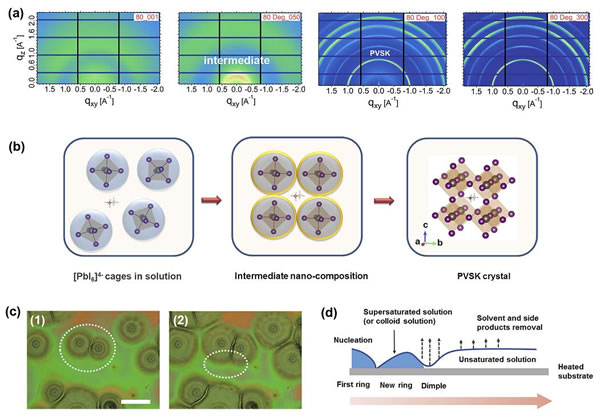With the increasingly severe problems of energy crisis and environmental pollution, green renewable energy such as solar energy has received extensive attention in recent years. With the improvement of photoelectric conversion efficiency and the reduction of production costs, solar cells increasingly highlight their broad application prospects. Organic-inorganic lead-halogen perovskite solar cells, as a rising star of new-type solar cells, have rapidly increased their photoelectric conversion efficiency from 3.8% to 22.1% in just seven years. Although perovskite solar cells have made major breakthroughs in efficiency, the research on the growth mechanism of perovskite materials and the formation mechanism of thin film morphology needs to be further strengthened. Based on this research, the perovskite materials are further studied. Cognition and the application of corresponding optoelectronic devices are of great significance.
Professor Zhu Rui and Academician Gong Qihuang from the “Extreme Optical Innovation Research Team†of Peking University’s School of Physics have conducted in-depth studies on the crystallization kinetics and morphology evolution of perovskite materials from precursors to polycrystalline films. This work combined with advanced characterization techniques such as grazing incidence X-ray diffraction (GIXD) and Fourier transform infrared spectroscopy based on synchrotron radiation, in situ real-time detection of perovskite materials from precursors to polycrystalline films, proposed in structural changes The “nano-intermediate assembly model†studies the crystallization and growth mechanism of perovskites at the molecular or nanoscale scale. At the same time, the parameters such as temperature and time in the process of perovskite crystallization are regulated, and the crystallization kinetics of the perovskite film printed is studied in a multi-dimensional manner.
In terms of mesoscale film morphology, the team used an in-situ heating experiment based on a composite optical microscope to observe the formation process of a one-step perovskite film, and established a “crystallization-depletion†physical model to illustrate cyclical calcium The formation mechanism of titanium ore thin film morphology. This study has comprehensively reported the crystal growth of perovskite materials from the molecular level to the mesoscale thin film morphology. In addition, the researchers also optimized and characterized the printed perovskite solar cells, obtained optoelectronic properties of the devices that are comparable to traditional spin-coating methods, and actively conducted perovskite solar cell conversions from laboratory research to industrialization. Exploration has a certain practical significance.
The research was published in the journal Nature Communications (Nat. Commun. 2017, 8, 15688). Dr. Hu Qin and Zhao Lijun, Ph.D. students in Zhu Rui's research group, were the co-first authors of the article. The study was conducted in collaboration with Prof. Thomas P. Russell and Dr. Liu Wei of the Lawrence Berkeley National Laboratory and Dr. Zhang Wei of the University of Surrey in the United Kingdom. This work was supported by the National Natural Science Foundation of China, the Ministry of Science and Technology, the State Key Laboratory of Artificial Microstructure and Mesoscopic Physics of Peking University, the “Extreme Optics Innovation Center of Extreme Opticsâ€, the “2011 Plan†Collaborative Innovation Center of Quantum Physical Science, and the “Thousand Talents Programâ€. "Supported by units such as the Lawrence Berkeley National Laboratory (LBNL).

(a) GIXD two-dimensional diffraction patterns at various stages during the conversion of perovskites from precursors to polycrystalline films; (b) nano-intermediate assembly models of perovskite crystals; (c) micrographs of printed films (d) Schematic representation of the periodic "crystallization-depletion" physical model.
Flood Light,Battery Flood Light,Stage Flood Light,Led Flood Light
EV LIGHT Guangzhou Co., Ltd , https://www.evlightpro.com
